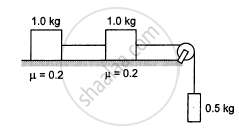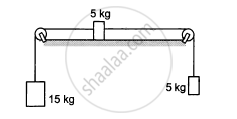Advertisements
Advertisements
Question
Two masses M1 and M2 are connected by a light rod and the system is slipping down a rough incline of angle θ with the horizontal. The friction coefficient at both the contacts is μ. Find the acceleration of the system and the force by the rod on one of the blocks.
Solution
From the free body diagram
R1 = M1g cos θ (1)
R2 = M2g cos θ (2)
T + M1g sin θ − M1a − μR1 = 0 (3)
T − M2g + M2a + μR2 = 0 (4)
From Equation (3),
T + M1g sin θ − M1 a − μM1g cos θ = 0 (5)
From Equation (4),
T − M2 g sin θ + M2 a + μM2 g cos θ = 0 (6)
From Equations (5) and (6),
g sin θ(M1 + M2) − a(M1 + M2) − μg cos θ (M1 + M2)
⇒ a(M1 + M2) = g sin θ(M1 + M2) = μg cos θ (M1 + M2)
⇒ a = g(sin θ − μ cos θ)a − g(sin θ − μ cos θ)
∴ The acceleration of the block (system) = g(sin θ − μcos θ)
The force exerted by the rod on one of the blocks is tension, T.
T = −M1g sin θ + M1a + μM1g cos θ
T = −M1g sin θ + M1(g sin θ − μg cos θ) + μM1g cos θ = 0
APPEARS IN
RELATED QUESTIONS
A body of mass M is kept on a rough horizontal surface (friction coefficient = μ). A person is trying to pull the body by applying a horizontal force but the body is not moving. The force by the surface on A is F, where
A block A kept on an inclined surface just begins to slide if the inclination is 30°. The block is replaced by another block B and it is found that it just begins to slide if the inclination is 40°.
Mark the correct statements about the friction between two bodies.
(a) Static friction is always greater than the kinetic friction.
(b) Coefficient of static friction is always greater than the coefficient of kinetic friction.
(c) Limiting friction is always greater than the kinetic friction.
(d) Limiting friction is never less than static friction.
A block is placed on a rough floor and a horizontal force F is applied on it. The force of friction f by the floor on the block is measured for different values of F and a graph is plotted between them.
(a) The graph is a straight line of slope 45°.
(b) The graph is a straight line parallel to the F-axis.
(c) The graph is a straight line of slope 45° for small F and a straight line parallel to the F-axis for large F.
(d) There is a small kink on the graph.
Suppose the block of the previous problem is pushed down the incline with a force of 4 N. How far will the block move in the first two seconds after starting from rest? The mass of the block is 4 kg.
A body of mass 2 kg is lying on a rough inclined plane of inclination 30°. Find the magnitude of the force parallel to the incline needed to make the block move (a) up the incline (b) down the incline. Coefficient of static friction = 0.2.
Repeat part (a) of problem 6 if the push is applied horizontally and not parallel to the incline.
In a children-park an inclined plane is constructed with an angle of incline 45° in the middle part (in the following figure). Find the acceleration of boy sliding on it if the friction coefficient between the cloth of the boy and the incline is 0.6 and g = 19 m/s2.

A body starts slipping down an incline and moves half metre in half second. How long will it take to move the next half metre?
The angle between the resultant contact force and the normal force exerted by a body on the other is called the angle of friction. Show that, if λ be the angle of friction and μ the coefficient of static friction λ ≤ tan−1 μ.
Consider the situation shown in the following figure. Calculate (a) the acceleration of the 1.0 kg blocks, (b) the tension in the string connecting the 1.0 kg blocks and (c) the tension in the string attached to 0.50 kg.

If the tension in the string in the following figure is 16 N and the acceleration of each block is 0.5 m/s2, find the friction coefficients at the two contact with the blocks.

The friction co-efficient between the table and the block shown in the following figure is 0.2. Find the tensions in the two strings.

The friction coefficient between a road and the type of a vehicle is 4/3. Find the maximum incline the road may have so that once had brakes are applied and the wheel starts skidding, the vehicle going down at a speed of 36 km/hr is stopped within 5 m.
The friction coefficient between an athelete's shoes and the ground is 0.90. Suppose a superman wears these shoes and races for 50 m. There is no upper limit on his capacity of running at high speeds. (a) Find the minimum time that he will have to take in completing the 50 m starting from rest. (b) Suppose he takes exactly this minimum time to complete the 50 m, what minimum time will he take to stop?
Consider the situation shown in the following figure. Suppose a small electric field E exists in the space in the vertically charge Q on its top surface. The friction coefficient between the two blocks is μ but the floor is smooth. What maximum horizontal force F can be applied without disturbing the equilibrium?
[Hint: The force on a charge Q bye the electric field E is F = QE in the direction of E.]

A block of mass 2 kg is pushed against a rough vertical wall with a force of 40 N, coefficient of static friction being 0.5. Another horizontal force of 15 N, is applied on the block in a direction parallel to the wall. Will the block move? If yes, in which direction? If no, find the frictional force exerted by the wall on the block.
